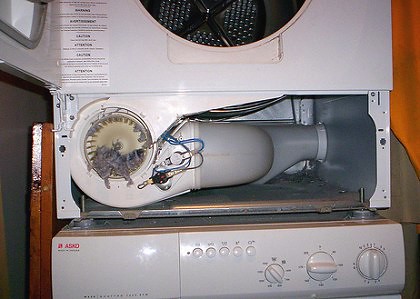Home-Tech: Washers & Dryers-2
Some info on choosing a dryer
I'm still looking at the Lowes' guide online to selecting a dryer. The first thing one needs to establish here is what type of power one has for the heating unit: electricity or gas. We're in the Pacific Northwest, so everything is either electric or propane (tank), so that's settled for us (and probably for you, too). Another obvious point is the need to coordinate capacities of dryers with washing machines; I'd think it's a reasonable assumption that you're buying the two together. However, an obvious corollary of this is that cheaper models are likely to scimp on the capacity of the dryer, assuming that a minority of consumers, mostly higher-income, will ever bother to check.

Other features include a cool-down cycle (after clothes are dry) in order to ensure they don't wrinkle; a moister-sensor, which monitors the humidity of the air in the dryer to prevent overdrying; and that's really about it. So I visited the excellent website of Fixitnow Samurai, which includes an entry on dismantling dryers (for diagnostics). I was extremely interested in this, since the Samurai is not only an expert on appliances with a broad understanding of physics and electronics, but also an outstanding writer and user of photographic aids.
To illustrate what dryers look like inside, he picks a very conventional model, the Norge (identical to the Admiral, Magic Chef, Montgomery Wards, and others). It looks like a very common, very cheap dryer. Here's a late model GE dryer (minus the drum). Samurai had a very low opinion of this model, which is so cheap it does not have a rear service panel.
Not sure what Samurai thought of the other models, but I think with six models he had covered the entire industry. However, with a couple of exceptions, I believe these are mostly older models. There was not a strong correlation between bells & whistles, and rigor of construction, either way. I would have expected the plain, functional exterior of the GE machine to be matched by a relatively solid and well-planned assembly—I would have been wrong. The Whirlpool looked pretty good (for one thing, the panels do not appear to warp dramatically on disassembly) but I suspect few of these machines are made by the parent company, I'm not sure we can deduce from this what current models look like under the hood.



0 Comments:
Post a Comment
<< Home